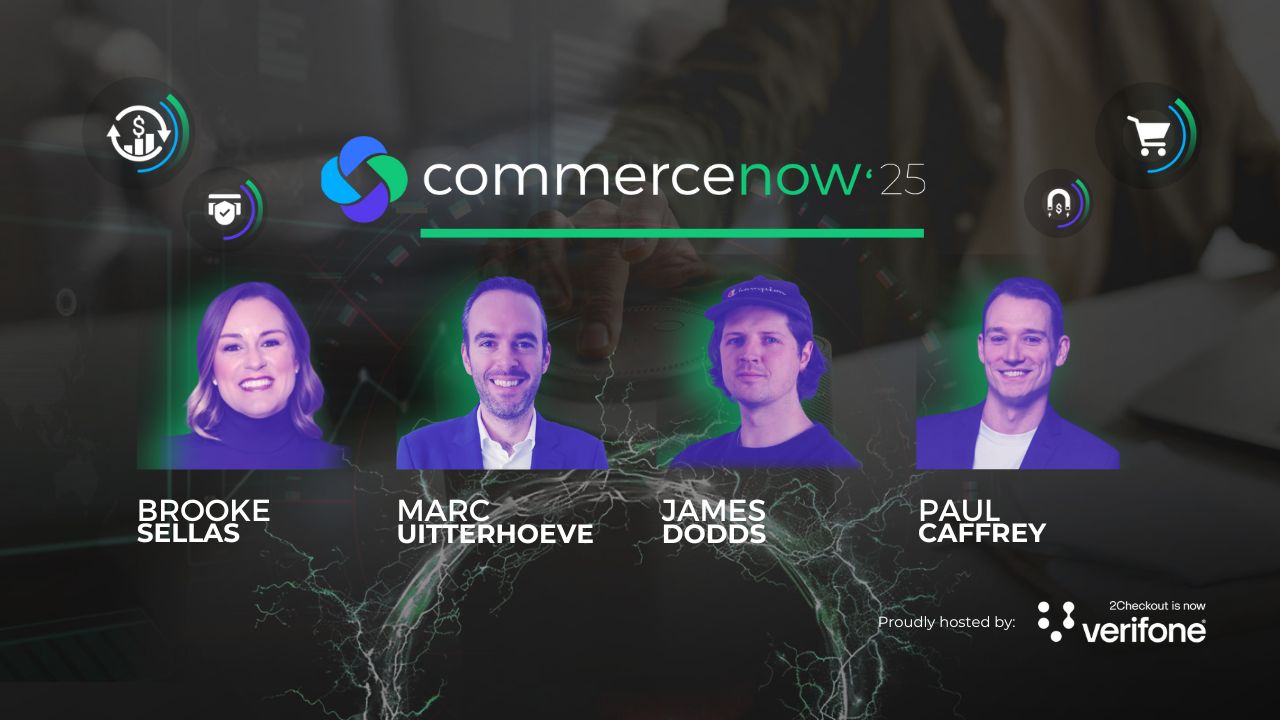Revenue growth isn’t only about bigger budgets, but rather about getting more from what you already have. That was the thread across CommerceNow’25. Each speaker shared clear steps businesses can use today.
In this wrap-up, we’ll explore top insights from sessions featuring Brooke Sellas, Marc Uitterhoeve, James Dodds, and Paul Caffrey.
Key highlights include:
- Content repurposing to turn one strong asset into a full campaign;
- Fixing funnel leaks by working four levers together: conversion rate, average order value, purchase frequency and revenue per user;
- Mobile-first social ads that win attention and strengthens brand signal;
- Preparation habits that raise win rates;
- Answer engine optimization for zero-click discovery of high-value content;
- Reviews and trust signals that compound at product and checkout.
Read on for main insights from every speaker.
Make Existing Content Work Harder
Brooke Sellas, Founder and CEO of B Squared Media, opens the webinar with a clear message for every SaaS brand: stop chasing new content and start getting more from what already works.
Her advice centers on a mindset shift – from creating constantly to optimizing consistently. As she put it herself: “no new content, just new results.”
Start with proven content
Brooke explains that the most effective campaigns begin with what’s already performing.
Whether it’s a webinar, a case study, or a blog post, strong results show where your audience is paying attention. Repurposing starts here, by identifying that “cornerstone” piece that has already proven its value.
Once a cornerstone is chosen, the goal is to turn it into multiple, smaller assets that extend its reach.
For example, a single video can become short clips, pull quotes, and graphics tailored for different channels. This way, teams multiply impact without adding new workload.
Create snackable moments
Brooke encourages marketers to look for the moments that spark emotion or curiosity. Pull short clips, standout quotes, charts, or visuals that make a clear point on their own.
These smaller parts help people notice, understand, and share faster:
- Clip 10 to 30 second video moments,
- Save strong one-liners and proof points,
- Turn key graphs or screenshots into simple visuals.
By breaking long-form content into smaller parts, SaaS brands can fill their calendar with ready-to-go material while keeping messaging consistent.
This strategy also allows teams to reinforce core ideas repeatedly, which is key to brand recall and trust.
Adapt for every platform
Here’s a simple idea Brooke shares that many forget: the same message doesn’t work everywhere.
She reminds that it’s important for teams to customize formats and tones for each channel and audience. Square videos work best for social feeds, vertical for Reels and Shorts, widescreen for YouTube.
Copy should shift too, what feels natural on LinkedIn may not work on TikTok or X.
She also advises staggering releases instead of posting everything at once. A planned schedule helps each piece get the right visibility and avoids overwhelming audiences.
Measure real engagement
Brooke’s most important reminder is to keep track of what truly matters. Comments, shares, and saves signal meaningful engagement, while likes don’t.
Real conversations show that content resonates and helps pinpoint what should be repurposed next.
AI tools can speed up this process. In her stack, Brooke uses Descript for editing, Sprout Social for optimal posting times, and SmarterQueue to refresh captions.
She adds that analytics platforms like Sprinklr reveal which topics, hashtags, or visuals consistently earn attention, turning them into the next set of “cornerstones”.
Think beyond search
Brooke closes her talk by urging teams to plan for better visibility in AI-driven searches.
That’s because answer engine optimization (also called AEO) helps brands appear in “zero-click” results, where users get answers directly from search or AI summaries.
Repurposed content that answers real questions stands a better chance of surfacing there.
For more best practices for adapting content to fit different platforms and audience and real-world examples, make sure to watch Brooke’s full session.
Strengthen the Funnel Before Scaling Traffic
Throughout his talk, CEO of Dexter Agency – Marc Uitterhoeve, emphasizes that many teams try to buy more traffic while key pages still lose buyers.
But, he argues, the better move is to raise the value of current visitors first.
He explains that growth comes from working smarter with the audience already in front of you, reducing friction, improving trust, and increasing how often customers buy or how much they spend each time.
Only when those areas are strong does it make sense to bring in new visitors.
Work the four growth drivers together
Marc outlines four key levers that determine how well a funnel performs:
- conversion rate,
- average order value,
- purchase frequency,
- and revenue per user.
When these move together, small improvements can multiply results.
He warns that focusing on a single metric, like conversion rate alone, often hides bigger issues. Hence why it’s important to remember: if one metric goes up while others fall, the overall outcome can still decline.
Build strong foundations first
Optimization starts with understanding the data. Marc advises checking analytics accuracy, figuring out the biggest drop-off points, and further watching how real users move through the site.
Once that’s clear, run a structured expert review.
His team, for instance, uses a checklist of over 500 points, all built on Baymard and Nielsen Norman research, to spot the friction that often goes unnoticed.
He points out that clean data and an unbiased review create a reliable base for future tests and ensure that experiments lead to genuine progress.
Judge tests by revenue, not by rate
Marc shares an interesting example of a company that added a cart cross-sell to raise average order value.
Conversions dropped, and total revenue fell by nearly $200K a year. Removing the cross-sell restored balance, with a 97.5% probability of higher revenue.
His takeaway from this case study is simple: every test should be measured by overall revenue per user, not one performance metric in isolation.
Treat reviews as a growth engine
Reviews are a compounding asset; they influence decisions at every stage, from first impressions to checkout.
This is why Marc recommends collecting different types of reviews, such as short text snippets, photos, or quick videos, to make them all feel authentic.
Strategic placement is also important. Reviews near product details or checkout can help ease buyer doubts, while post-purchase prompts help gather fresh feedback that keeps the cycle going.
Get more tips on boosting your online sales by watching Marc’s session here.
Create Social Ads That Win the First Two Seconds
James Dodds is Creative Lead at Vervaunt. In his webinar talk, he focuses on one of the many challenges every brand faces online: earning attention before the scroll.
His approach centers on creative for paid social that connects fast, feels native to each platform, and builds a clear brand signal over time.
Design for mobile-first experience
Most viewers now experience ads vertically and within seconds. In fact, 46% of online purchase conversions happen within the first two seconds of attention, according to James.
He explains that mobile-first ad creative isn’t a nice-to-have – it’s the default.
Videos should be framed for 9:16, with text and visuals kept inside safe zones so nothing important gets cropped. He adds that well-designed mobile content can lower cost per acquisition by more than 12% across major platforms.
He also reminds teams to think about flow: strong visuals, quick pacing, and an easy message hierarchy. Your viewer should understand what the ad is about even with the sound off.
Win attention in the first two seconds
James highlights that nearly half of online purchases start with engagement within two seconds of an ad appearing, hence that opening moment is everything.
A good creative hook might come from a quick visual change that makes people stop scrolling, a sharp question, or a relatable pain point shown fast.
He calls this “earning the stop,” and it happens before the logo or product appears. If those first frames grab viewer’s interest, the rest of the message has a great chance to land.
Build around intimacy and immediacy
James shares two creative levers that consistently improve performance:
- Intimacy: showing real people, faces, and direct eye contact. Ads featuring human expressions can boost results up to 81%,
- Immediacy: quick movement, close shots, and product-in-use scenes that feel natural. These create a sense of energy and authenticity.
Together, these elements make content more relatable and build trust in the brand behind it.
Strengthen your brand signal
James points out that strong creative needs a clear brand behind it, because brand identity multiplies results.
According to him, ads with clear brand cues, like consistent colors, logos, and tone, perform up to four times better. Consistency helps audiences recognize the message even when they only see it briefly.
Keep variety in the mix
It’s true that algorithms reward brands that constantly test and experiment.
This is why James recommends developing five to ten creative themes, each showing a different side of the brand or customer story.
This diversity helps reach wider audiences without creative fatigue. He points to campaigns from client brands like Osprey that increased click-through rates by 80% and lowered cost per click by 50% after testing more ad styles and variations.
Lastly, James reminds viewers that people trust creators more than brands, so partner with relevant creators and seed UGC to lift attention and conversion.
Connect across the funnel
Creative should match where the viewer is in the buying journey. James outlines four stages of the marketing funnel:
- Awareness: focus on storytelling and emotion,
- Consideration: show clear product benefits or social proof,
- Direct response (conversion): make the offer direct and easy to act on,
- Retention: share community stories and user-generated content.
By matching social ads to intent, brands can turn quick attention into long-term results.
Watch James’ whole CommerceNow’25 session to gain more actionable tips on engineering scroll-stopping content that drives real performance across Meta, TikTok, and beyond.
Win More Deals Through Better Preparation
Paul Caffrey – founder of the The Prepared Seller – closes this webinar with a reminder that execution in sales starts long before the first meeting.
His message is straightforward: the teams that prepare best, win most. The “work before the work” is what separates average sellers from top performers.
Preparation is the advantage
Paul shares data from recent benchmarks showing that just 14% of sellers generated 80% of total revenue last year.
He argues that this number isn’t luck, but rather preparation. Top performers invest time in learning about the buyer, shaping insight-led conversations, and defining what success looks like for both sides.
He hence recommends setting aside about a quarter of the meeting length for preparation.
That time should go toward research, reviewing notes, and developing one sharp insight to open with. Remember: a strong, unexpected insight earns attention faster than any pitch.
Know who to sell to
High win rates come from focus, so the best sellers qualify hard against their ideal customer profile instead of chasing every lead.
According to Paul, the most successful teams have roughly 77% of their pipeline within ICP, while struggling teams average just 22%.
Focusing on the right opportunities also means saying “no” early. The time saved can be reinvested in buyers who are most likely to convert, shortening deal cycles and increasing average deal size.
Define the real problem
Paul points out that credibility comes from understanding the customer’s problem better than they do.
It’s true that when sellers can frame the challenge clearly and connect it to a measurable outcome, buyers trust that they also have the right solution.
As he sums it up himself: “if you can define the problem better than your customer, they’ll believe you have the solution.”
Plan the micro and the macro
Paul defines two types of decisions:
- micro decisions: immediate next steps, such as scheduling the next call or confirming stakeholders,
- macro decisions: larger commitments, like agreeing on success criteria or budget.
He advises sellers to separate micro decisions from macro decisions, because deals move forward when every step is clear.
Documenting both keeps momentum and removes guesswork. He recommends using a simple mutual success plan, like for example a one-page summary of what both sides will do next, why it matters, and when it will happen.
Ask for referral and plan for chaos
Paul also reminds teams that referrals are five times more effective than cold outreach. Yet most sellers ask once, at the end of a deal, and stop.
He suggests asking for referrals multiple times instead, especially right after a customer sees value.
And finally, he mentions that every plan should leave room for the unexpected. “Plan for chaos” means anticipating changes in schedules, budgets, or decision makers so you can adapt quickly when things shift.
Don’t miss out on Paul’s session to discover actionable tactics to amplify your fair advantage and maximize your sales.
Bringing It All Together
Across these four sessions, one idea stands out: real wins come from doing the basics well, again and again.
The takeaway message is that most businesses already have what they need to grow. The opportunity lies in refining, testing, and staying close to what customers respond to.
To take these ideas further, watch the full CommerceNow’25 event now and see each strategy in action.










